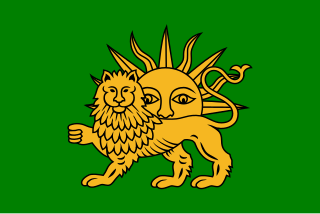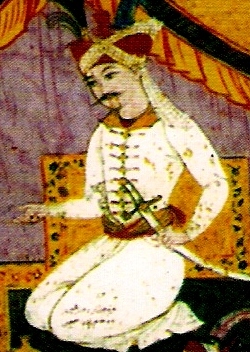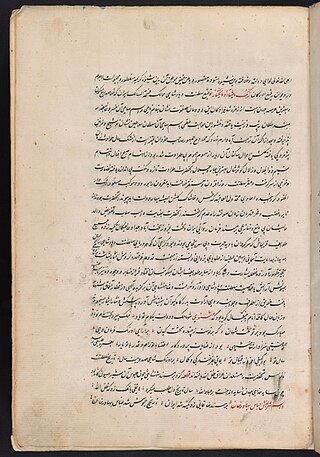Related Research Articles

The Safavid dynasty was one of Iran's most significant ruling dynasties reigning from 1501 to 1736. Their rule is often considered the beginning of modern Iranian history, as well as one of the gunpowder empires. The Safavid Shāh Ismā'īl I established the Twelver denomination of Shīʿa Islam as the official religion of the Persian Empire, marking one of the most important turning points in the history of Islam. The Safavid dynasty had its origin in the Safavid order of Sufism, which was established in the city of Ardabil in the Iranian Azerbaijan region. It was an Iranian dynasty of Kurdish origin, but during their rule they intermarried with Turkoman, Georgian, Circassian, and Pontic Greek dignitaries, nevertheless, for practical purposes, they were Turkish-speaking and Turkified. From their base in Ardabil, the Safavids established control over parts of Greater Iran and reasserted the Iranian identity of the region, thus becoming the first native dynasty since the Sasanian Empire to establish a national state officially known as Iran.

Tahmasp I was the second shah of Safavid Iran from 1524 until his death in 1576. He was the eldest son of Shah Ismail I and his principal consort, Tajlu Khanum.

Ismail I was the founder and first shah of Safavid Iran, ruling from 1501 until his death in 1524. His reign is often considered the beginning of modern Iranian history, as well as one of the gunpowder empires. The rule of Ismail I is one of the most vital in the history of Iran. Before his accession in 1501, Iran, since its conquest by the Arabs eight-and-a-half centuries earlier, had not existed as a unified country under native Iranian rule. Although many Iranian dynasties rose to power amidst this whole period, it was only under the Buyids that a vast part of Iran properly returned to Iranian rule (945–1055).

Safi-ad-Din Ardabili was a poet, mystic, teacher and Sufi master. He was the son-in-law and spiritual heir of the Sufi master Zahed Gilani, whose order—the Zahediyeh—he reformed and renamed the Safaviyya, which he led from 1301 to 1334.

Ismail II was the third Shah of Safavid Iran from 1576 to 1577. He was the second son of Tahmasp I with his principal consort, Sultanum Begum. By the orders of Tahmasp, Ismail spent twenty years imprisoned in Qahqaheh Castle; whether for his recurrent conflicts with the realm's influential vassals, or for his growing popularity between the Qizilbash tribes, resulting in Tahmasp becoming wary of his son's influence.

The history of Ottoman–Safavid relations started with the establishment of the Safavid dynasty in Persia in the early 16th century. The initial Ottoman–Safavid conflict culminated in the Battle of Chaldiran in 1514, and was followed by a century of border confrontation. In 1639, Safavid Persia and Ottoman Empire signed the Treaty of Zuhab which recognized Iraq in Ottoman control, and decisively parted the Caucasus in two between the two empires. For most of it, the Zuhab treaty was a consolidation of the Peace of Amasya of about a century earlier.

Iskandar Beg Munshi was an Iranian court scribe and chronicler, who is principally known for his historical book of Tarikh-e Alam-ara-ye Abbasi, which focuses on early Safavid history, especially the reign of Shah Abbas I.
Ali Mirza Safavi, also known as Soltan-Ali Safavi, was the penultimate head of the Safavid order. Having grown wary of his political power, Ali Mirza was captured by the Ak Koyunlu and spent several years in captivity in Fars before being released in 1493 by prince Rostam. In the ensuing period he and his men assisted the prince in defeating Baysonqor bin Yaqub. A year later however, in 1494, now perceiving the Safavid order as a threat to his own position, Rostam ordered for the execution of Ali Mirza Safavi. Realizing his inevitable fate, shortly before his death, Ali Mirza Safavi appointed his brother Ismail as his successor. Ismail, in turn, eventually came to establish the Safavid Empire, with the regnal name Ismail I.

Idris Bitlisi, sometimes spelled Idris Bidlisi, Idris-i Bitlisi, or Idris-i Bidlisi, and fully Mevlana Hakimeddin İdris Mevlana Hüsameddin Ali-ül Bitlisi, was an Ottoman Kurdish religious scholar and administrator.

Safavid Iran, Safavid Persia or the Safavid Empire,, officially known as the Guarded Domains of Iran, was one of the largest and long-standing Iranian empires after the 7th-century Muslim conquest of Persia, which was ruled from 1501 to 1736 by the Safavid dynasty. It is often considered the beginning of modern Iranian history, as well as one of the gunpowder empires. The Safavid Shāh Ismā'īl I established the Twelver denomination of Shīʿa Islam as the official religion of the empire, marking one of the most important turning points in the history of Islam.
Gokcheh Sultan Ziyadoghlu Qajar, better known as Shahverdi Sultan, was a Safavid military leader of Turkoman origin, who served as the governor of Karabakh and Ganja during the reign of king Tahmasp I.
Fereydun Khan Cherkes was a Safavid official and military commander of Circassian origin, who served as the governor (beglarbeg) of Astarabad in 1605/06–1620, during the reign of king Abbas I.
Mohammad Khan Tokhmaq Ustajlu, also commonly known as Tokhmaq Khan Ustajlu, was a 16th-century Iranian official, diplomat and military leader from the Turkoman Ustajlu tribe. He was appointed as governor (beglarbeg) of Erivan Province in 1568–1575. Thereafter, he led an embassy to the Ottoman Empire. On his return, he participated in some judicial developments, and was reappointed as governor of Erivan Province in 1578. In the same year, he served as main commander at the Battle of Çıldır during the Ottoman–Safavid War of 1578–1590, where his army was routed. A few years later, in 1583, Mohammad Khan Tokhmaq's second tenure over the Erivan Province was brought to an end due to encroachments by the Ottomans, who controlled the province until 1604.
Makhdum Sharifi Shirazi was a Persian Sunni statesman and author, who served as the minister of religious affairs (sadr) during the reign of Ismail II, and ultimately took refuge in the Ottoman Empire, where he wrote the al-Nawaqez le-bonyān al-rawafez, a sizable anti-Shia argumentative book.
Mirza Mohammad Mihrani known as Mirza Mohammad Talish was an Iranian nobleman and prominent military commander of Talysh origin. He was a descendant of Mihranids and his ancestors were the hereditary governors of Astara. Mirza Mohammad was the governor of Astara, and later became the Safavid governor of Yazd. He was married to a sister of Sultan-Ali Beg Chākirlu, the Aq Qoyunlu governor of Ardabil.
Mohammad Beg Talish was a dignitary military commander of Talysh origin, who resided in Khalkhal and served the Safavid order. He married with Shah-Pasha Khatun when her father, Shaykh Junayd, was alive. Shah-Pasha Khatun was the only surviving sister of Shaykh Haydar (1459–1488). This marriage bring an alliance which helped the Safavid dynasty during the last phase of their struggle for power.

Rudolph P. Matthee, best known as Rudi Matthee, is John and Dorothy Munroe Distinguished Professor of History in the History Department at the University of Delaware, teaching Middle Eastern history and specializing in the history of early modern Iran. He received his PhD in 1991 from the University of California. Matthee is a member of the Association for the Study of Persianate Societies, for which he also functioned as president twice in 2003-2005 and 2009–2011. He is the author of numerous books and articles on Safavid and Qajar Iran.
The Battle of Sharur occurred in July 1501. It ended with a decisive victory for the Safavid army. After this victory, the way of the Safavids to Tabriz was opened. Alvand Mirza disappeared from the political scene.
Mohammad Masum Isfahani, was an Iranian bureaucrat and historian, who is known for his historical chronicle of Kholasat al-Siar, composed during the reign of Shah Safi.
Abd al-Hoseyn Khatunabadi was a 17th-century Persian historian of Safavid Iran, who is principally known for his historical chronicle of Vaqa'e' al-senin, referred to as the "most important source from the last decades of Safavid rule."
References
- 1 2 3 "Kioumars Ghereghlou". Orcid. Retrieved 1 November 2021.
- ↑ "Kioumars Ghereghlou". profiles.stanford. Retrieved 1 November 2021.